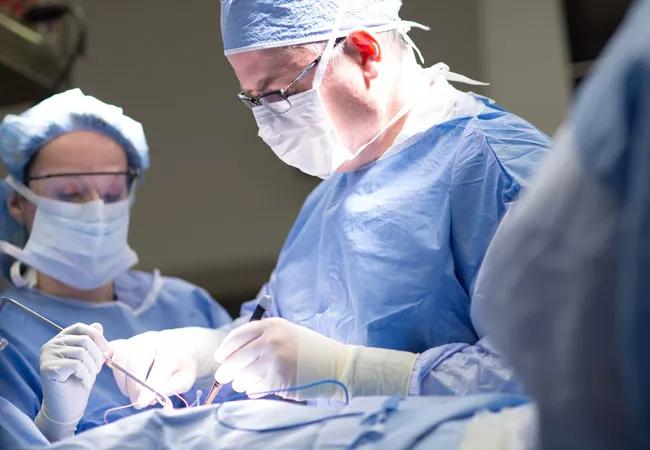Extends the benefits of NSM to more patients and improves outcomes

Nipple-sparing mastectomy (NSM) was first developed in 2001 by Cleveland Clinic breast surgeon Dr. Joseph Crowe for use in prophylactic surgeries. In 2013, two Cleveland Clinic surgeons developed the first new technique for performing NSM: tumor ultrasound-guided incisions (TUGI).
Advertisement
Cleveland Clinic is a non-profit academic medical center. Advertising on our site helps support our mission. We do not endorse non-Cleveland Clinic products or services. Policy
Over the years NSM indications have expanded to include mastectomies in select patients. As most studies have reported positive oncologic outcomes, rates of NSM have increased to 40 percent at some centers. For patients, NSM offers major psychological benefits. “Having a breast removed is devastating,” says Stephen R. Grobmyer, MD, co-leader of the Cleveland Clinic Comprehensive Breast Cancer Program. “The more we can preserve of the breast, the better patients feel about themselves.”
NSM has been limited to patients with smaller tumors that aren’t close to the nipple areolar complex (NAC) and are accessible using radial, inframammary or periareolar incisions. Dr. Grobmyer and Risal S. Djohan, MD, a surgeon in the Department of Plastic Surgery, developed TUGI to make NSM available to a greater number of patients and improve outcomes.
Using ultrasound to guide mastectomy, the surgeon can tailor the location of the incision to where the cancer is found on the breast. Cleveland Clinic patients chosen for mastectomies using TUGI had tumors that were either very close to the skin, in regions of the breast unsuited to traditional incisions, or both. Otherwise, the tumors met established guidelines for NSM (T2 or less, no tumor involvement of the NAC). Ordinarily, these patients would have undergone skin-sparing or simple mastectomies and lost their NAC.
The two surgeons and colleagues conducted a retrospective chart review which is reported in Clinical Breast Cancer. From 2013 to 2016, Drs. Grobmyer and Djohan performed 94 mastectomies, including 31 nipple-sparing procedures of which 13 were performed using TUGI. The majority of TUGI patients (77 percent) had infiltrating ductal carcinoma with a median tumor size of 1.5 cm and a median tumor-to-NAC distance of 5 cm. Pathologic stage distribution was: 15 percent stage 0, 31 percent stage 1A, 38 percent stage 2A and 15 percent 2B.
Advertisement
Sixty-two percent of the incisions were in the upper quadrants of the breast; the remaining incisions were lower inner quadrant (eight percent), supra-areolar transverse (15 percent) and infra-areolar transverse (15 percent). All patients underwent immediate tissue expander replacement, 46 percent with accellular dermal matrix and most have had final reconstruction to date. TUGI does not increase the difficulty of performing immediate and final reconstruction. “We’ve shown that it’s feasible and safe to do reconstruction from an incision in the upper quadrant,” says Dr. Djohan. “By preserving breast anatomical structures like the nipple areolar complex, TUGI avoids the need for another surgery to reconstruct the nipple.”
Only one case (eight percent of study group) had a wound infection and two cases (15 percent) had NAC necrosis requiring reoperation. The reported necrosis rates range from 0 to 20 percent in conventional NSM.
No patients had positive margins; two recent studies have shown that most positive margins in NSM occur with the intramammary incision, particularly with upper quadrant tumors. At a median follow-up of 17 months, no cancer recurrence was observed. “TUGI is an approach that should be considered among surgical options to give patients the best outcome,” says Dr. Grobmyer. “Surgical margins are a major factor in the success of cancer procedures. With TUGI, we can use an incision that is close to the cancer and remove more pathologic tissue for a more careful operation. We were able to achieve greater margins with good cosmetic results.”
Advertisement
“Cleveland Clinic breast and plastic surgeons work as a team to achieve the best possible outcome for the patient,” says Dr. Djohan.
TUGI extends ultrasound to mastectomies for the first time and brings the benefits of NSM to more patients.
Research will continue at Cleveland Clinic to review patient outcomes and further refine and validate this novel technique.
Advertisement
Advertisement

Study demonstrates superior visualization of occult primary lesions

New device offers greater tumor control for malignant liver lesions

Patient factors and cancer characteristics are key to deciding between focal therapies and whole gland treatment

Rare cancer presents as unresolved changes of the nipple

Two-day procedure prevents neurologic compromise for octogenarian

Preoperative chemotherapy enables successful surgical resection

Study finds high levels of a CD8 T-cell subpopulation to be predictive of ICI resistance

Low-strength electrical current identifies at-risk patients with greater accuracy than tape measurement